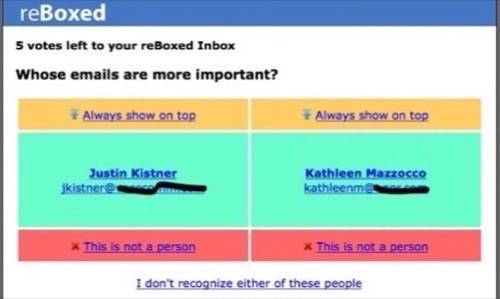Former Gmail engineer Gabor Cselle has been working on improving email for years. This week he built a new system for prioritizing all the emails in your inbox. It’s called ReBoxed, and it relies on crowdsourced A/B preference voting on email senders, and Cselle built it in just 3 days.

I’m not sure it’s going to work as it’s implemented so far – but it sure is interesting.
Here’s how it works. First ReBoxed uses Gmail’s wonderful Contacts API to grab your Gmail contacts list without needing to ask for your password. This step takes a few minutes, but is delightfully easy, transparent and secure.
Then you’re shown 20 pairs of contacts who have sent you email recently and asked which sender in each pair tends to send the most important emails. In addition to prioritizing one over the other you can also designate one of the contacts as always high-priority, mark them as a non-human source for placement in a bulk sender box or say that you don’t recognize either name.
You aren’t allowed to say that the two contacts are of equal importance. Cselle says he wants everyone to be forced to choose. Sometimes that’s hard.

All of the prioritized contacts are then analyzed from all users in anonymous aggregate to determine the general priority level of senders. In theory this means that even after choosing between only 40 people, you can benefit from everyone else’s list of 40 as well.
The end result is a new window into your Gmail inbox. Your emails are more or less chronological there, but bulk senders are separated and your priorities, presumably with some influence from everyone else’s priorities, also influence the order things are displayed in.
There’s a whole lot of other ways this aggregate data could be parsed as well. There’s a lot of potential here.
Why This Might Not Work
This system of prioritization is reminiscent of something Yahoo is working on, part of a larger initiative the company calls Inbox 2.0. That system works primarily through analysis of passive signals, though. It sees whose emails you click to read and who you send email to most often. It also allows you to designate people as particularly important.
ReBoxed has a lot of potential, but if it relies on explicit prioritization it’s hard to imagine that scaling. In my tests I also had a lot of my 40 sender slots taken up by blog commenters, something that’s less useful than personal emails. Perhaps a more sophisticated system of filtering would help with that. Update: I see now that there is an option to go back and “play the voting game” again. That’s good.
I’d feel more inclined to use a system that provided a superior UI over Gmail’s, asked me to prioritize senders through occasional prompts and relied extensively on monitoring which emails I clicked on. It might be helpful as well to make calls to my Google Profile and profiles elsewhere around the web to identify contacts that are important enough to me to include on many different networks.
It might not work – but after only 3 days of coding there’s still a whole lot of room for innovation here. The use of crowdsourced prioritization is really interesting. If I were to get an email from ReadWriteWeb founding editor Richard MacManus for the first time for example, I’d love to have that message flagged for my attention based on lots of other people saying that Richard sends important emails. That’s really cool.
ReBoxed is a small project that presumably could become a part of Cselle’s larger email startup company, ReMail. That service is yet to launch but if this is the kind of creativity that will be included there, we’re excited to see it.
Word of ReBoxed’s launch is floating around the social webs but credit for the mention that led to this post goes to Atul Arora on Twitter.










